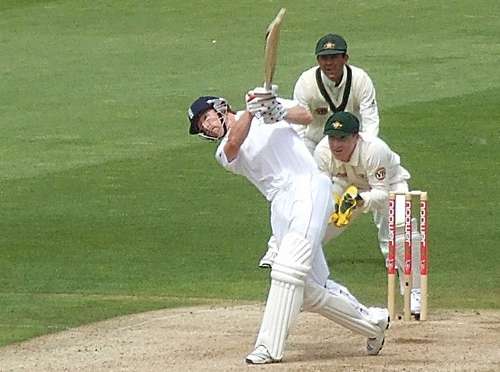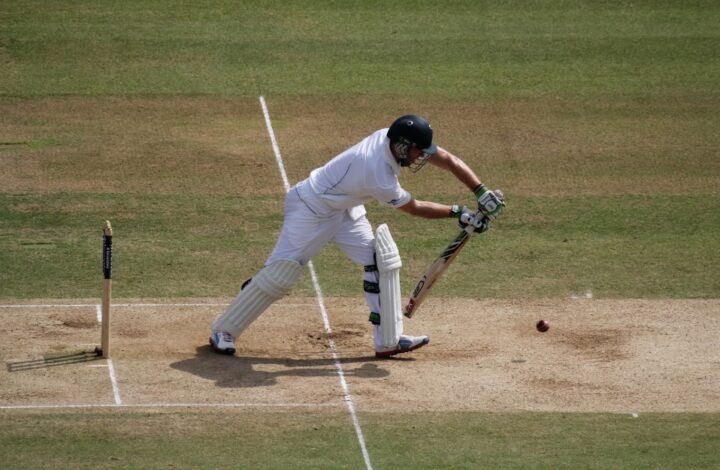Today we welcome Geoffrey Bunting back to TFT. He’s penned a lovely tribute to a true England hero …
There’s something strangely endearing about ugly things. Walking through a pet rescue centre we might immediately be drawn to the cutest kitten or the most-friendly puppies but it’s often the misfits that maintain our attention; the one-eyed, three-legged survivors that elicit the most deep-seated sense of care. National Geographic suggests it is “baby schema” – a basic human instinct to care for and nurture something. A need to protect it. But whatever it is, it’s deeply ingrained within us and has made internet sensations of otherwise ungainly animals: sloths, blobfishes, frogs – all “big eyes, large heads, and soft bodies.”
In 2004, I was unsure of cricket. I was half in and half out. What was in was really in: it wanted to know everything about the game, the other half was more interested in reading The Lord of the Rings for the sixth time. It could have gone either way. I might have persisted without encouragement or I might have lost interest and developed an inordinate admiration for curling. But in that imbalanced time, England’s tour of South Africa happened and while some were wearing the carpet raw with their jaws as Kevin Pietersen pummelled three ODI hundreds so good that they seemed to make the whole of South Africa go from hating to loving him overnight, what arrested me was another name: PD Collingwood.
Literally. Next to Vaughan, Bell, Gough, and Jones “Collingwood” struck me, for whatever reason, as a funny-looking name. Immediately that oddity in the scorecard had me rooting for him. And then I saw him bat.
I don’t know whether my first subconscious instinct when seeing Paul Collingwood was to nurture and protect him. Perhaps, deep down, my teenage brain kidded me into thinking that, if I watched keenly enough, I might fix him. But something in that awkward shuffle across the crease, that throttling of the bat-handle that made every shot a shovel, and that ungainly swipe to cow-corner just gripped me. It was the sort of technique at which many coaches would despair; a technique that, by its very existence, spoke of a tremendous stubborn brilliance completely at odds with the elegance of Bell and Vaughan or the raw power of Pietersen. This was something else – an abstract other that I could not put my finger on – I only knew that I wanted to see more.

It’s a beautiful sunny day in the Welsh capital as Paul Collingwood comes to the crease, when he leaves 245 balls and almost six hours later it’s still a beautiful sunny day in the Welsh capital but now there’s hope. England were looking down the barrel of a crippling defeat to set up the 2009 Ashes that would set a tone they were unlikely to overcome. But an obdurate marathon from Collingwood gave them a chance – a chance England grabbed to draw a game that spring boarded them to a series win and from which Australia struggled to recover.
Watching him bat in that innings was like walking into a room painted bright orange and dark blue. It’s jarring, unexpected, and you don’t know that you could get away with the same thing – and yet it grows on you. There’s a striking contrast with what is regarded as orthodox that engages you in a way normalcy has failed to do so. It “feels absurd and a little unreal” but it “inspires questions.” Good questions. Questions about what exactly normal should be.
It’s easy to dissect a strange technique and call it inadequate – it’s almost an unkindness how readily batsmen’s deficiencies are highlighted when they’re struggling – but an ugly technique that works, that brings success when every instinct says it shouldn’t, is something to behold. When a technically correct batsman succeeds it is all too simple to imagine the years of throwdowns, of drills, of coaching. But ugly techniques have no sense of privilege to them, they’re about hard work and determination. Critics of Tom Westley’s recent foray into test cricket will assert that a predominantly leg-side game is not a recipe for success, but Collingwood – who jokes he learned to cover-drive after the age of thirty-five – would beg to differ. He demonstrates that the game isn’t all about technique; it’s not as reliant on high elbows and correct footwork as many may think. More often than not it’s in the mind.
As Tim Wigmore puts it, “To see Collingwood play was to witness a triumph of willpower.” To mirror this in another sport, Billy Beane, of Oakland Athletics fame, tells a story about his playing days.
“Billy remembers sitting with Lenny [Dykstra] in a Mets dugout watching the opposing pitcher warm up. ‘Lenny says, “So who’s that big dumb ass out there on the hill?” And I say, “Lenny, you’re kidding me, right? That’s Steve Carlton. He’s maybe the greatest left-hander in the history of the game… He’s got heat and also maybe the nastiest slider ever.” … Lenny sits there for a while longer as if he’s taking that in. Finally he just says, “Shit, I’ll stick him.” I’m thinking, that’s a magazine cover out there on the hill and all Lenny can think is that he’ll stick him.’ ”
Beane was regarded as one of the greatest baseball prospects scouts had ever seen, but it was Dykstra who went on to a lengthy career in Major League Baseball while Beane, on the back of average performances that saw him move from the Mets to the Minnesota Twins and finally the Athletics, retired at twenty-seven to become a scout. While many would say Beane was the perfect example of what a baseball player should look like, he believed he had neither the mental acuity nor the fundamental desire to play baseball, where, according to Beane, Dykstra was “perfectly designed, emotionally… [he had] no concept of failure.”
Many better-looking players have tried and failed in test cricket thanks to issues of temperament, so too have players with better first-class records failed to live up to that potential. We sometimes criticise selectors for picking on character, for sticking with the likes of Keaton Jennings too long just because they think he’s got the right personality, but there’s little doubt that certain players can overcome average statistics through mental toughness – from just wanting it more. That was the impression Paul Collingwood gave every time he batted: it didn’t matter who was bowling, he was going to stay there, he was going to “stick him.”
His game was one of immense concentration and stubborn fortitude that could win over even the most ardent of technical purists. Yes, there were struggles – slumps that invited minute scrutiny of that unorthodox technique, but Collingwood, like the very best players, overcame them. It was joyful to watch, inspirational even. And though it was easy to take heart from a player driving to succeed despite the ostensible obstacle of his own technique, the grinding stoicism that has become so ingrained in our memories of him belied a power and aggression that would see him hammer England’s then-fastest ODI half-century in 2008, destroy Bangladesh in 2005, and help him drive England to their first men’s global trophy. In truth, an obdurate style masked a canny adaptability and, as much as his statistics may feel incongruous with his technique – he averaged 40.56 in tests, after all – so too did the impression of that technique fail to reveal his true value to the England team.
We all remember his rear guard blockathons in Cardiff and Centurion in 2009 and Cape Town 2010 but we often neglect his fluent hundreds, laden with nimble footwork to the spinners, against Pakistan or his 206 against McGrath and Warne in the torrid Adelaide test of 2006 (not to mention his 22 not out as England capitulated in the third innings). For years, Paul Collingwood stood up when everyone else failed. In the mid-2000s he kept an inconsistent batting side going and as that batting solidified into the best England has had under Andrew Strauss he grew into a vital cog of the Flower machine, simultaneously the finisher of good innings and saviour from calamities.
For so much of his career, while Collingwood was still at the crease, there was a sense not of miracles waiting to happen that sometimes accompanied Kevin Pietersen and now hovers eagerly behind Ben Stokes but of a welcome stability and dependability that often went unnoticed amid the success of the team but few batsmen have embodied since. When, upon retiring, Collingwood declared he had “given every last ounce of energy” to the game we believed it – we’d seen it every time he went out to bat.

I’m not saying Paul Collingwood made me fall in love with the game. When I started playing at fourteen, I just wanted to get out of the house. That I happened to become a nuggety batsman who could only play to leg was simply a coincidence born out of the fact I wasn’t very good. But Hiroshi Nittono, director of the Cognitive Psychophysiology Laboratory at Osaka University, has suggested that things that we find strange, ugly, or off-putting are often what we find most engaging, that someone will look at something unorthodox and “actually find it interesting and want to approach and know it a little more.”
I can see, in retrospect, that it was this exact phenomenon that drew me into cricket. Unimpressed with the technical correctness of so many players watching someone so at odds with that purism, whose own success appeared to be the result of nothing but hard work and concentration, was a delight to someone in need of a hero in the game. There were ugly batsmen before Collingwood and after him we have seen the likes of George Bailey and Rory Burns flourish – I’m not even sure Collingwood was an ugly batsman. Rather, he was unorthodox – different – capable of inspiring a “spark of weird happiness” every time he shuffled across the crease. These days we make heroes of the miracle workers, we play Pietersen’s hundred against South Africa over and over, inundate television pictures with Stokes at the World Cup or at Headingley, but before them Paul Collingwood was working a more mundane variety of magic built upon a tremendous eye, willpower, and, at times, a worryingly low backlift.
Geoffrey Bunting








I remember being appalled that criticism was levelled against Collingwood after Adelaide 2006 for not being more aggressive/shielding the tail in the second innings. For crying out loud, he scored 228 for once out. There were many reasons England lost, Collingwood wasn’t one of them.
(Not to get distracted, but that test summed up the difference between England and Australian cricket. When Australia scored 550-odd in their first innings against India in 2002/3 at Adelaide and still ended up losing – ie identical scenario to England in 06 – they dusted themselves off and won the next match. Whereas every England supporter, support staff and, it seems, player gave up after their Adelaide humiliation and capitulated in all the remaining matches.)
Totally agree with thrust of this article – and you don’t even mention his fielding! I always thought that when Collingwood was in the side it sharpened everyone’s fielding. Add that factor to the runs he saved himself and he was probably worth 20 or 30 runs an innings before he even picked up a bat. A great addition to any side.
Lovely article. I agree sith every word. I remember so well a one handed catch he took which defied belief. I can see it now but cannot recall when it took place. I am sure somebody here will kniw which one I am referring to!
This one? Amazing.
I want to pay tribute to the Paul Collingwood who returned to Durham and stayed with them throughout the vissitudes imposed by the ECB. He carried on playing after his forties to help shepherd the youngsters who had to carry the side after the seniors left. It was a ghastly time for the Club broken by the severest penalties ever applied in cricket in order to demote them from the First Division and then to keep them in the Second. He could have retired after a great career. But he isn’t that kind of bloke. There was a cap on nearly everything applied by the shameless ECB including on players and on wages and even on prizes in the unlikely event that Durham might win some money. It was reckoned that the Club had been punished to the extent that they might not survive. Paul Collingwood was the answer to that script. His most heroic efforts were kept to the last. Well done Colly.
I quite agree. The ECB’s behaviour was disgraceful.
Yep, Colly’s achievements for Durham rank with with those of his fine England career. Taking us from rock bottom of Division 1 when he was appointed captain midway through 2012 to the most unlikely of County Championship titles the following year. Being there for us when others we’d developed were plucked away by richer counties after the disgraceful ECB punishment (for, let’s remember, doing what the ECB encouraged us to do in the first place, by investing to develop Riverside for international cricket) to lead what we can only hope to be a long slow recovery. I only wish we could clone him and get another 23 years’ service out of him!
We can all marvel at the silky skills of Lord Gower and King Viv, but as they possess the sort of natural talent we can only dream about we don’t really identify with them. Every team we support needs a dependable plodder or two who can do the dirty work, whether its cricket, footie or rugby. They allow the more talented players more opportunity to display their skills.
The players we do identify with are the obviously less talented who have made the grade by their own application, something we can all aspire to do. I remember a particularly obdurate Aussie opener from the 70’s called Bruce Laird, who managed a decent test average by not giving his wicket away. He was a typical nugget and as an opener myself I watched him more closely for tips than Amiss or Jameson, who were opening the batting for my county Warwickshire at the time. I knew what my club side wanted of me for the first hour or so, which seemed to be the ethos Laird adopted with the Aussies.
Collingwood was slightly different in that he was more than a sticker, especially in white ball cricket, but being a slightly awkward looking batsman gave him that air of vulnerability we all feeel at the crease.
With the BBC currently showing 90’s highlights of the Windies tests here you forget what an ugly looking but nonetheless effective customer Jack Russell was with the bat. When someone breaks as many technical rules as him bowlers must be incredibly frustrated to know where to bowl. He moves about at the crease like a jack rabbit, plays accross the line habitually, yet still manages to lay the middle on it a lot.
Fantastic player, every team needs someone like him, the one does the hard yards and the dirty work. Unglamorous, but extremely effective.